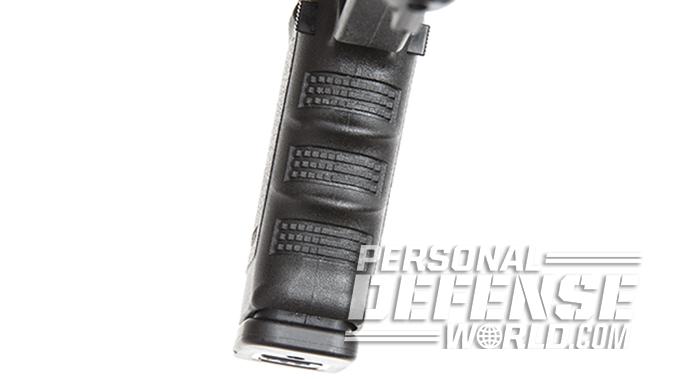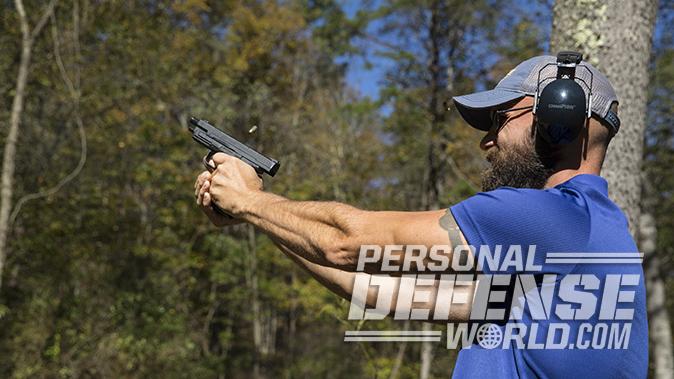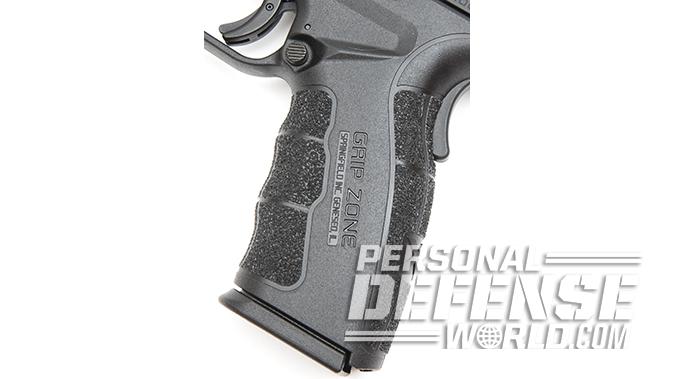Everyone has their own interests and quirks when it comes to products they like—especially firearms. A longtime favorite category for myself has been higher- capacity .45 ACP pistols. The .45 ACP round is as American as it gets, plus who doesn’t want an extra 45 to 70 percent more magazine capacity if it’s available?
Trends do change, and now we’re in the midst of a 9mm renaissance where proponents are once again heralding that chambering’s virtues as a fight-stopper because of advancements in bullet technology. That’s certainly a credible sentiment, but it also applies to other calibers as well, including the venerable .45 ACP.
So, given my druthers, I’d rather go with a full-capacity .45 than a 9mm when it comes to a full-sized pistol for open carry or home protection. In that vein, for this “Tale of the Tape” installment we’ll be putting two 13+1-capacity .45s head to head: the Springfield Armory XD Mod.2 Tactical and the Glock 21SF.
Advertisement — Continue Reading Below
The Contenders
Both Glock and Springfield have had high-capacity .45s for quite some time now and have seemingly influenced each other’s designs over the years. The first iteration of the Glock 21 occurred in 1991, while Springfield’s introduction of its high-capacity XD-45 didn’t happen until approximately 15 years later, around 2006. The XD-45 was touted for its ergonomics and impressive comfort considering its 13-round magazine capacity.
Oddly enough, in 2007 Glock began producing its Short Frame (SF) models for its large pistols in 10mm and .45 ACP. The SF models reduced the circumference of the grip at the backstrap and included other minor changes. This resulted in a pistol that handled and felt better than the original Glock 21 while still keeping its own 13-round capacity.
Advertisement — Continue Reading Below
In 2014, Springfield introduced its new XD Mod.2 series of pistols with several enhancements. The most recent entry in that line is the new XD Mod.2 Tactical in .45 ACP that was just released this year.
Fresh Meat
The XD Mod.2 pistols have a number of changes that were made to improve upon the performance of the original line. One of the more obvious changes was the incorporation of a fiber-optic front sight, which I appreciate more and more each year with advancing age. The Mod.2 versions also come with slimmer slides and frames than the originals, making them even more comfortable and easier to carry.
The Mod.2 pistols also have what Springfield calls “GripZone” texturing. It essentially divides the grip up into three categories, and a specific texture type is applied to each area. The user’s purchase on the pistol has also been augmented. For the Mod.2 pistols, Springfield created a nice relief behind the triggerguard and redesigned the beavertail, both of which allow the user to get a higher grip on the pistol to help mitigate recoil.
Advertisement — Continue Reading Below
Other niceties include slimmer controls like the takedown lever, a low-profile rear sight, an accessory rail, an ambidextrous magazine release and more aggressive slide serrations at both the front and rear. These are updates for the entire Mod.2 line of pistols. The main difference with the .45 ACP Tactical model is the inclusion of a 5-inch barrel rather than the 4-inch version that comes on the Service model.
The Stalwart
Glock is, well, Glock. After a quarter of a century of producing the high-capacity Glock 21, there really have been only a few significant changes over the years with new models. Oh, the company will fuss with the internals a bit, giveth finger grooves and then taketh them away, but there hasn’t really been a seismic shift or major overhaul with the design. The closest Glock has come is when it created the SF version of the Glock 21.
The Glock 21SF is a Gen3-style pistol. But, lest you think I’m putting Glock at a disadvantage by not comparing the most recent generation against the Springfield, that is not the case. I am simply using the model I think is Glock’s best iteration of a high-capacity .45 ACP pistol.
Advertisement — Continue Reading Below
I have acquired and used a Glock 21 Gen4 but still prefer the Glock 21 SF, despite the introduction of the interchangeable backstraps. Others seem to feel the same way, because even though Gen4s came out in 2010, the Glock 21 SF is still being sold.
The Glock 21SF I picked up when it was introduced has a true Picatinny rail, but most of them (including Gen4s) use Glock’s proprietary rail design. I personally prefer the Picatinny rail. I am also partial to the feel and handling of the Glock 21 SF over the Gen4 model. While I don’t care for the texturing or the enlarged magazine release of the Gen4, I like the finger grooves on the SF. And, for whatever reason, I shoot better with the Glock 21 SF. Go figure.
Entering The Ring
During the handling comparisons and while firing the Glock and Springfield, it was easy to find certain features on each pistol that were better than the other. However, it was very difficult to come to an overall conclusion. For instance, there’s no question that the XD Mod.2 had a slimmer and more comfortable grip. In fact, the texturing had just the right balance between being too slick and too irritating.
Advertisement — Continue Reading Below
On the other hand, the Glock 21SF is not as tall as the Springfield, and I was able to get a higher grip relative to the bore, despite the relief changes made to the Mod.2 version. This difference resulted in more control over the 21 SF during recoil with less muzzle flip. Though it was an admittedly small advantage since the Mod.2 Tactical was very soft shooting and easy to control as well.
Both pistols have accessory rails, ambidextrous magazine releases and the exact same capacity, so those features are pretty much a wash. However, the XD Mod.2 Tactical would not accept my SureFire X400 Ultra laser/light unit, which fit perfectly on the Glock 21SF’s rail.
There are mixed feelings out there over the grip safety on the XD. I actually like the concept of a grip safety. It adds another layer of security against accidental discharges without requiring the user to perform a second separate action before firing. It’s in the grip and is thereby instinctively activated.
Advertisement — Continue Reading Below
While both are matte black, polymer-framed, striker-fired pistols with a similar finish, the XD Mod.2 Tactical is more aesthetically pleasing to the eye, for whatever that is worth to the individual consumer. For some, this type of pistol is all about function, not appeal, but others may view it differently.
Impressions
During the range testing, I found that I picked up the fiber-optic front sight on the XD Mod.2 faster in daylight than the sights on the Glock 21 SF, though I typically opt for night sights anyway. There is also a marked difference between the trigger pulls of each pistol.
Advertisement — Continue Reading Below
The XD Mod.2 Tactical’s trigger broke at an average of 5.14 pounds while the Glock 21 SF’s averaged 5.78 pounds. Despite the lighter weight, the trigger on the Springfield required a bit of travel even after resistance was met. It felt like stretching a rubber band to its limit before it broke, though it was a very smooth pull.
On the other hand, the Glock’s trigger didn’t have all the travel of the XD Mod.2’s, though, once it broke, there’s a disconcerting vibration that feeds back to the trigger finger. However, I got over the Glock’s trigger pull long ago, and despite the XD Mod.2’s smoother and lighter pull, the Glock’s reset is much shorter, making it quicker to fire follow-up shots. It’s dealer’s choice as to which feature is more important to the user.
Both pistols seemed to shoot equally well off-hand, but I still shot them from a rest at 25 yards to wring out the best results with three different loads from Speer, Sig Sauer and Federal Premium. The Glock’s average five-shot group size was 2.44 inches while the XD Mod.2’s average group ran about 2.63 inches. When you include the human factor, that’s just about dead even.
Advertisement — Continue Reading Below
The Verdict
As mentioned before, it’s a difficult process to determine which of these pistols would be better overall for the shooter who wants a high-capacity .45. The pistols match up very closely in most areas. Even the MSRP for both pistols ($637) is exactly the same. Both pistols had no malfunctions while being fired, so reliability wasn’t up for discussion as a deciding factor, either.
Basically, what I think will serve as the tipping point on deciding between these two pistols for the consumer is user preference for “feel” and handling. One might prefer the lighter trigger pull of the XD Mod.2 Tactical or the faster reset of the Glock 21SF. The Glock’s shorter height might do the trick for some while the longer sight radius of the XD Mod.2 Tactical might be preferred by others.
It will be the little things that decide it for each person. Both pistols have similar finishes, are very accurate and provide great value for the money. Spec to spec, they are matched very closely to each other, and both perform at a near-equal level. All that’s left are the finer points, but the good news is that, either way, you won’t go wrong.
Springfield XD Mod.2 Tactical Specs
- Caliber: .45 ACP
- Barrel: 5 inches
- OA Length: 8.1 inches
- Weight: 31 ounces (empty)
- Grip: Polymer
- Sights: Fiber-optic front, two-dot rear
- Action: Striker-fired
- Finish: Matte black
- Capacity: 13+1
- MSRP: $637
Glock 21SF Specs
- Caliber: .45 ACP
- Barrel: 4.6 inches
- OA Length: 8.03 inches
- Weight: 29.3 ounces (empty)
- Grip: Polymer
- Sights: Fixed
- Action: Safe Action
- Finish: Matte black
- Capacity: 13+1
- MSRP: $637
For More Information
Glock
glock.com
Springfield Armory
springfield-armory.com
This article was originally published in the March/April 2018 issue of “Combat Handguns” To order a copy, visit outdoorgroupstore.com.




































